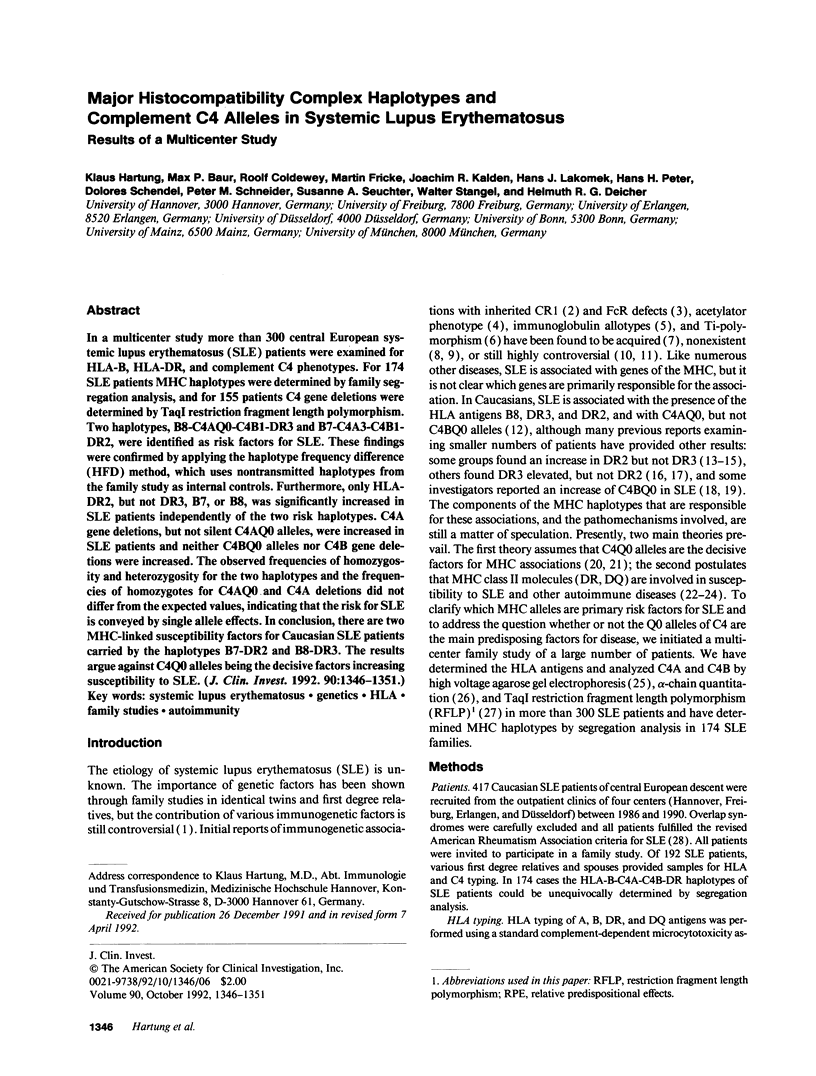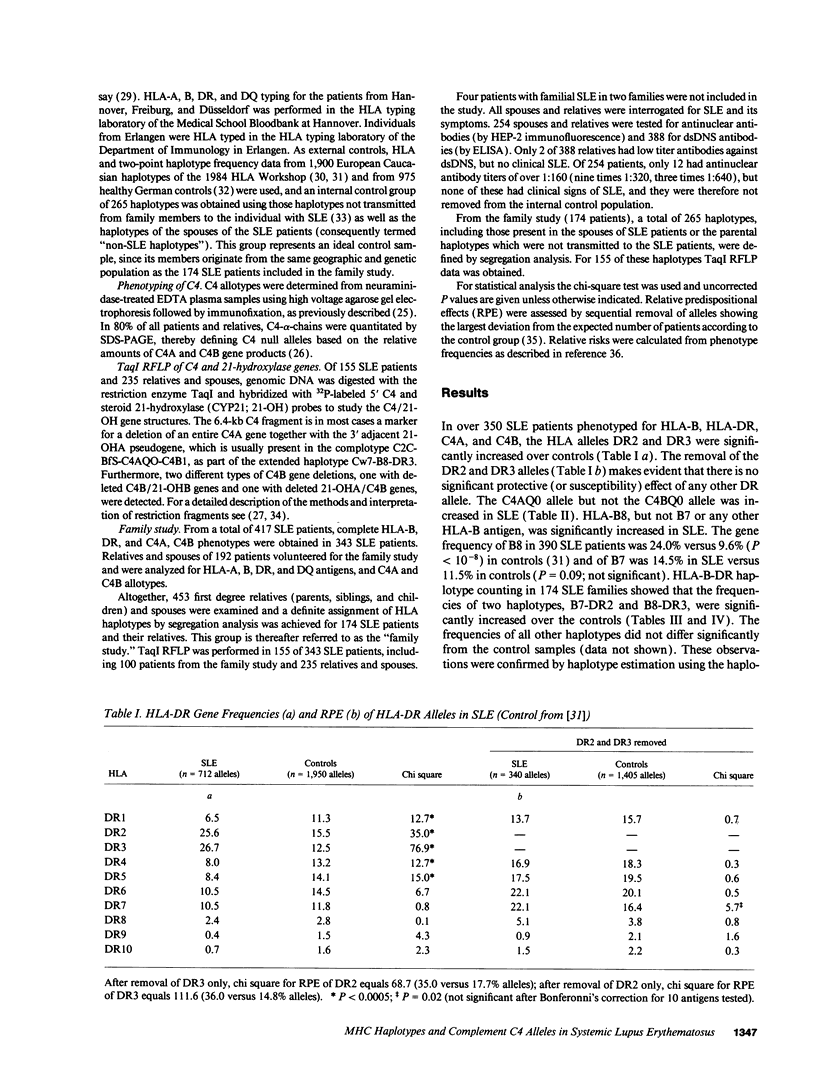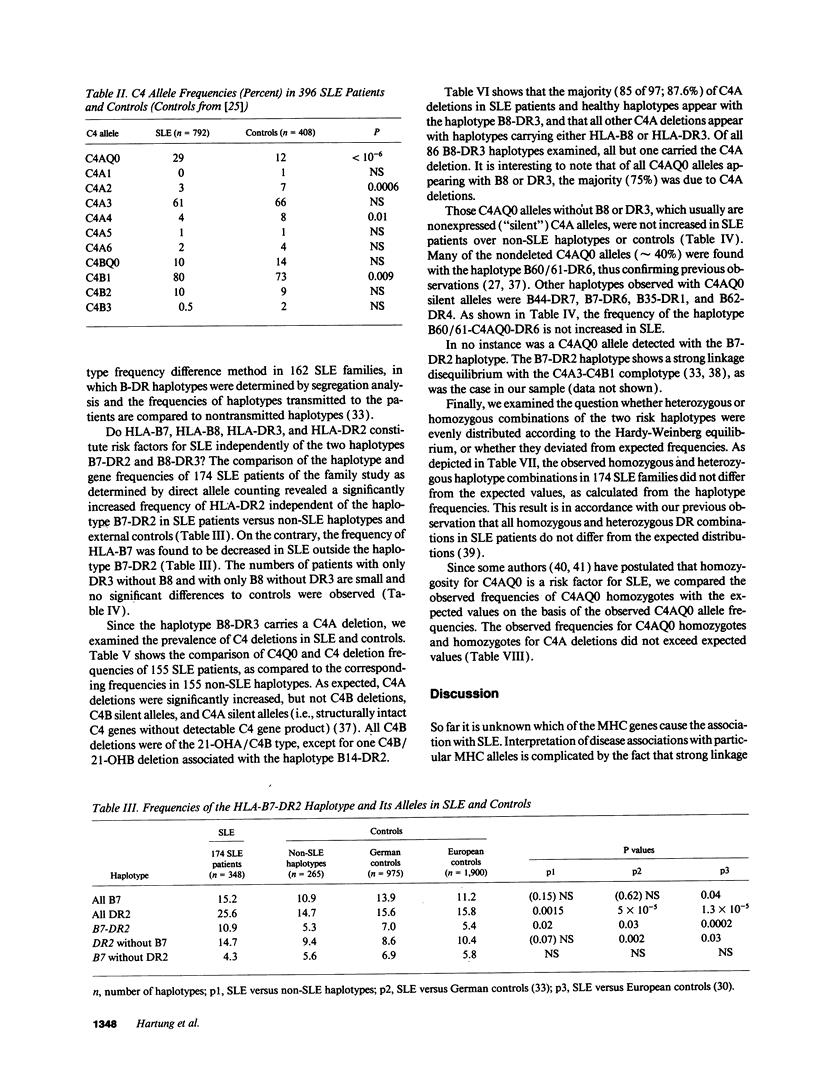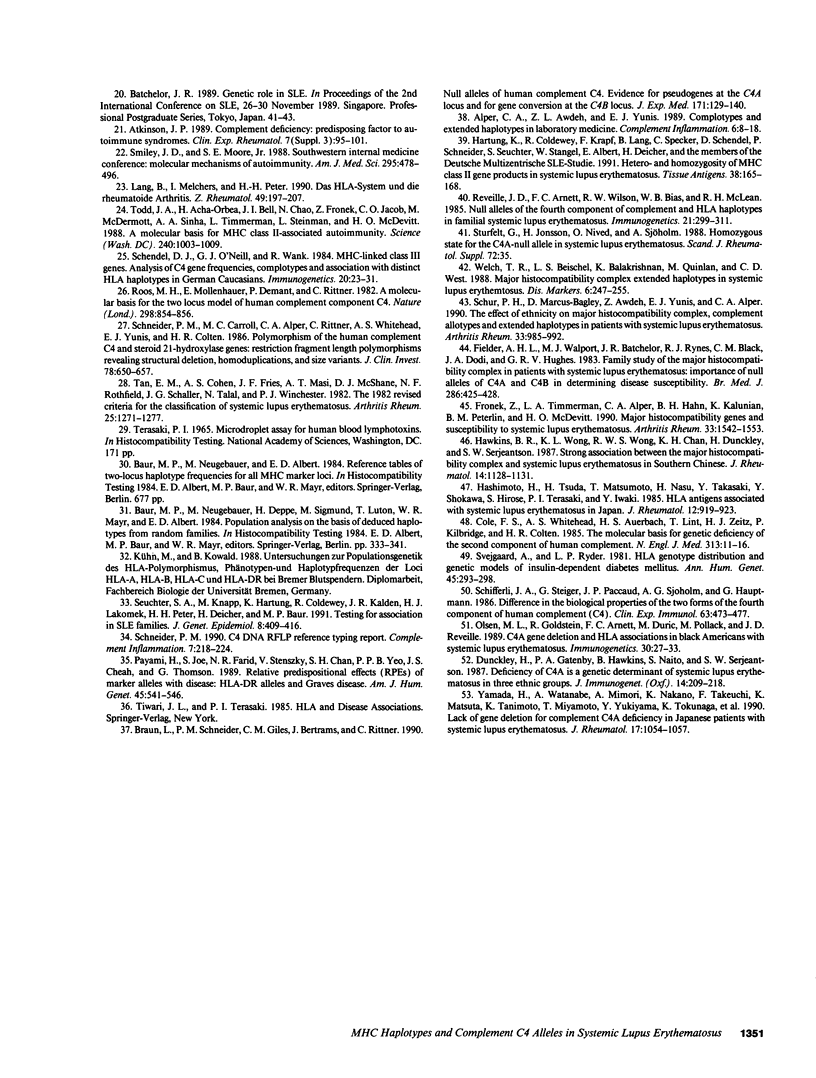Abstract
In a multicenter study more than 300 central European systemic lupus erythematosus (SLE) patients were examined for HLA-B, HLA-DR, and complement C4 phenotypes. For 174 SLE patients MHC haplotypes were determined by family segregation analysis, and for 155 patients C4 gene deletions were determined by TaqI restriction fragment length polymorphism. Two haplotypes, B8-C4AQ0-C4B1-DR3 and B7-C4A3-C4B1-DR2, were identified as risk factors for SLE. These findings were confirmed by applying the haplotype frequency difference (HFD) method, which uses nontransmitted haplotypes from the family study as internal controls. Furthermore, only HLA-DR2, but not DR3, B7, or B8, was significantly increased in SLE patients independently of the two risk haplotypes. C4A gene deletions, but not silent C4AQ0 alleles, were increased in SLE patients and neither C4BQ0 alleles nor C4B gene deletions were increased. The observed frequencies of homozygosity and heterozygosity for the two haplotypes and the frequencies of homozygotes for C4AQ0 and C4A deletions did not differ from the expected values, indicating that the risk for SLE is conveyed by single allele effects. In conclusion, there are two MHC-linked susceptibility factors for Caucasian SLE patients carried by the haplotypes B7-DR2 and B8-DR3. The results argue against C4Q0 alleles being the decisive factors increasing susceptibility to SLE.
Full text
PDF





Selected References
These references are in PubMed. This may not be the complete list of references from this article.
- Alper C. A., Awdeh Z. L., Yunis E. J. Complotypes and extended haplotypes in laboratory medicine. Complement Inflamm. 1989;6(1):8–18. doi: 10.1159/000463067. [DOI] [PubMed] [Google Scholar]
- Alvarellos A., Ahearn J. M., Provost T. T., Dorsch C. A., Stevens M. B., Bias W. B., Arnett F. C. Relationships of HLA-DR and MT antigens to autoantibody expression in systemic lupus erythematosus. Arthritis Rheum. 1983 Dec;26(12):1533–1535. doi: 10.1002/art.1780261222. [DOI] [PubMed] [Google Scholar]
- Atkinson J. P. Complement deficiency: predisposing factor to autoimmune syndromes. Clin Exp Rheumatol. 1989 Sep-Oct;7 (Suppl 3):S95–101. [PubMed] [Google Scholar]
- Batchelor J. R., Fielder A. H., Walport M. J., David J., Lord D. K., Davey N., Dodi I. A., Malasit P., Wanachiwanawin W., Bernstein R. Family study of the major histocompatibility complex in HLA DR3 negative patients with systemic lupus erythematosus. Clin Exp Immunol. 1987 Nov;70(2):364–371. [PMC free article] [PubMed] [Google Scholar]
- Braun L., Schneider P. M., Giles C. M., Bertrams J., Rittner C. Null alleles of human complement C4. Evidence for pseudogenes at the C4A locus and for gene conversion at the C4B locus. J Exp Med. 1990 Jan 1;171(1):129–140. doi: 10.1084/jem.171.1.129. [DOI] [PMC free article] [PubMed] [Google Scholar]
- Celada A., Barras C., Benzonana G., Jeannet M. Increased frequency of HLA-DRw3 in systemic lupus erythematosus. Tissue Antigens. 1980 Mar;15(3):283–288. doi: 10.1111/j.1399-0039.1980.tb00919.x. [DOI] [PubMed] [Google Scholar]
- Cole F. S., Whitehead A. S., Auerbach H. S., Lint T., Zeitz H. J., Kilbridge P., Colten H. R. The molecular basis for genetic deficiency of the second component of human complement. N Engl J Med. 1985 Jul 4;313(1):11–16. doi: 10.1056/NEJM198507043130103. [DOI] [PubMed] [Google Scholar]
- Dunckley H., Gatenby P. A., Hawkins B., Naito S., Serjeantson S. W. Deficiency of C4A is a genetic determinant of systemic lupus erythematosus in three ethnic groups. J Immunogenet. 1987 Aug-Oct;14(4-5):209–218. doi: 10.1111/j.1744-313x.1987.tb00383.x. [DOI] [PubMed] [Google Scholar]
- Dunckley H., Gatenby P. A., Serjeantson S. W. T-cell receptor and HLA class II RFLPs in systemic lupus erythematosus. Immunogenetics. 1988;27(5):393–395. doi: 10.1007/BF00395137. [DOI] [PubMed] [Google Scholar]
- Fielder A. H., Walport M. J., Batchelor J. R., Rynes R. I., Black C. M., Dodi I. A., Hughes G. R. Family study of the major histocompatibility complex in patients with systemic lupus erythematosus: importance of null alleles of C4A and C4B in determining disease susceptibility. Br Med J (Clin Res Ed) 1983 Feb 5;286(6363):425–428. doi: 10.1136/bmj.286.6363.425. [DOI] [PMC free article] [PubMed] [Google Scholar]
- Foad B., Litwin A., Zimmer H., Hess E. V. Acetylator phenotype in systemic lupus erythematosus. Arthritis Rheum. 1977 Apr;20(3):815–818. doi: 10.1002/art.1780200309. [DOI] [PubMed] [Google Scholar]
- Fronek Z., Timmerman L. A., Alper C. A., Hahn B. H., Kalunian K., Peterlin B. M., McDevitt H. O. Major histocompatibility complex genes and susceptibility to systemic lupus erythematosus. Arthritis Rheum. 1990 Oct;33(10):1542–1553. doi: 10.1002/art.1780331012. [DOI] [PubMed] [Google Scholar]
- Gladman D. D., Terasaki P. I., Park M. S., Iwaki Y., Louie S., Quismorio F. P., Barnett E. V., Liebling M. R. Increased frequency of HLA-DRW2 in SLE. Lancet. 1979 Oct 27;2(8148):902–902. doi: 10.1016/s0140-6736(79)92713-2. [DOI] [PubMed] [Google Scholar]
- Hartung K., Coldewey R., Krapf F., Lang B., Specker C., Schendel D., Schneider P., Seuchter S., Stangel W., Albert E. Hetero- and homozygosity of MHC class II gene products in systemic lupus erythematosus. The Members of the Deutsche Multizentrische SLE-Studie. Tissue Antigens. 1991 Oct;38(4):165–168. doi: 10.1111/j.1399-0039.1991.tb01890.x. [DOI] [PubMed] [Google Scholar]
- Hartung K., Coldewey R., Röther E., Pirner K., Specker C., Peter H. H., Kalden J. R., Lakomek H. J., Deicher H., de Lange G. G. Immunoglobulin allotypes in systemic lupus erythematosus--results of a central European multicenter study. SLE Study Group. Exp Clin Immunogenet. 1991;8(1):11–15. [PubMed] [Google Scholar]
- Hartung K., Fontana A., Klar M., Krippner H., Jörgens K., Lang B., Peter H. H., Pichler W. J., Schendel D., Robin-Winn M. Association of class I, II, and III MHC gene products with systemic lupus erythematosus. Results of a Central European multicenter study. Rheumatol Int. 1989;9(1):13–18. doi: 10.1007/BF00270284. [DOI] [PubMed] [Google Scholar]
- Hashimoto H., Tsuda H., Matsumoto T., Nasu H., Takasaki Y., Shokawa Y., Hirose S., Terasaki P. I., Iwaki Y. HLA antigens associated with systemic lupus erythematosus in Japan. J Rheumatol. 1985 Oct;12(5):919–923. [PubMed] [Google Scholar]
- Hawkins B. R., Wong K. L., Wong R. W., Chan K. H., Dunckley H., Serjeantson S. W. Strong association between the major histocompatibility complex and systemic lupus erythematosus in southern Chinese. J Rheumatol. 1987 Dec;14(6):1128–1131. [PubMed] [Google Scholar]
- Hochberg M. C., Boyd R. E., Ahearn J. M., Arnett F. C., Bias W. B., Provost T. T., Stevens M. B. Systemic lupus erythematosus: a review of clinico-laboratory features and immunogenetic markers in 150 patients with emphasis on demographic subsets. Medicine (Baltimore) 1985 Sep;64(5):285–295. [PubMed] [Google Scholar]
- Kumana C. R., Chan M. M., Wong K. L., Wong R. W., Kou M., Lauder I. J. Lack of association between slow acetylator status and spontaneous lupus erythematosus. Clin Pharmacol Ther. 1990 Aug;48(2):208–213. doi: 10.1038/clpt.1990.137. [DOI] [PubMed] [Google Scholar]
- Lang B., Melchers I., Peter H. H. Das HLA-System und die rheumatoide Arthritis. Z Rheumatol. 1990 Jul-Aug;49(4):197–207. [PubMed] [Google Scholar]
- Moldenhauer F., David J., Fielder A. H., Lachmann P. J., Walport M. J. Inherited deficiency of erythrocyte complement receptor type 1 does not cause susceptibility to systemic lupus erythematosus. Arthritis Rheum. 1987 Sep;30(9):961–966. doi: 10.1002/art.1780300901. [DOI] [PubMed] [Google Scholar]
- Olsen M. L., Goldstein R., Arnett F. C., Duvic M., Pollack M., Reveille J. D. C4A gene deletion and HLA associations in black Americans with systemic lupus erythematosus. Immunogenetics. 1989;30(1):27–33. doi: 10.1007/BF02421466. [DOI] [PubMed] [Google Scholar]
- Payami H., Joe S., Farid N. R., Stenszky V., Chan S. H., Yeo P. P., Cheah J. S., Thomson G. Relative predispositional effects (RPEs) of marker alleles with disease: HLA-DR alleles and Graves disease. Am J Hum Genet. 1989 Oct;45(4):541–546. [PMC free article] [PubMed] [Google Scholar]
- Reveille J. D., Arnett F. C., Wilson R. W., Bias W. B., McLean R. H. Null alleles of the fourth component of complement and HLA haplotypes in familial systemic lupus erythematosus. Immunogenetics. 1985;21(4):299–311. doi: 10.1007/BF00430796. [DOI] [PubMed] [Google Scholar]
- Roos M. H., Mollenhauer E., Démant P., Rittner C. A molecular basis for the two locus model of human complement component C4. Nature. 1982 Aug 26;298(5877):854–856. doi: 10.1038/298854a0. [DOI] [PubMed] [Google Scholar]
- Schendel D. J., O'Neill G. J., Wank R. MHC-linked class III genes. Analysis of C4 gene frequencies, complotypes and associations with distinct HLA haplotypes in German Caucasians. Immunogenetics. 1984;20(1):23–31. doi: 10.1007/BF00373444. [DOI] [PubMed] [Google Scholar]
- Scherak O., Smolen J. S., Mayr W. R. Prevalence of HLA-DRw2 not increased in systemic lupus erythematosus. N Engl J Med. 1979 Sep 13;301(11):612–612. doi: 10.1056/NEJM197909133011114. [DOI] [PubMed] [Google Scholar]
- Schifferli J. A., Steiger G., Paccaud J. P., Sjöholm A. G., Hauptmann G. Difference in the biological properties of the two forms of the fourth component of human complement (C4). Clin Exp Immunol. 1986 Feb;63(2):473–477. [PMC free article] [PubMed] [Google Scholar]
- Schneider P. M. C4 DNA RFLP reference typing report. Complement Inflamm. 1990;7(4-6):218–224. doi: 10.1159/000463150. [DOI] [PubMed] [Google Scholar]
- Schneider P. M., Carroll M. C., Alper C. A., Rittner C., Whitehead A. S., Yunis E. J., Colten H. R. Polymorphism of the human complement C4 and steroid 21-hydroxylase genes. Restriction fragment length polymorphisms revealing structural deletions, homoduplications, and size variants. J Clin Invest. 1986 Sep;78(3):650–657. doi: 10.1172/JCI112623. [DOI] [PMC free article] [PubMed] [Google Scholar]
- Schur P. H., Marcus-Bagley D., Awdeh Z., Yunis E. J., Alper C. A. The effect of ethnicity on major histocompatibility complex complement allotypes and extended haplotypes in patients with systemic lupus erythematosus. Arthritis Rheum. 1990 Jul;33(7):985–992. doi: 10.1002/art.1780330710. [DOI] [PubMed] [Google Scholar]
- Seuchter S. A., Knapp M., Hartung K., Coldewey R., Kalden J. R., Lakomek H. J., Peter H. H., Deicher H., Baur M. P. Testing for association in SLE families. Genet Epidemiol. 1991;8(6):409–416. doi: 10.1002/gepi.1370080607. [DOI] [PubMed] [Google Scholar]
- Smiley J. D., Moore S. E., Jr Molecular mechanisms of autoimmunity. Am J Med Sci. 1988 May;295(5):478–496. doi: 10.1097/00000441-198805000-00014. [DOI] [PubMed] [Google Scholar]
- Stoppa-Lyonnet D., Gougerot A., Poirier J. C., Schmid M., Busson M., Marcelli A. Etudes familiales du lupus érythémateux systémique. Marqueurs HLA et complotypes. Pathol Biol (Paris) 1986 Jun;34(6):773–777. [PubMed] [Google Scholar]
- Svejgaard A., Ryder L. P. HLA genotype distribution and genetic models of insulin-dependent diabetes mellitus. Ann Hum Genet. 1981 Jul;45(Pt 3):293–298. doi: 10.1111/j.1469-1809.1981.tb00340.x. [DOI] [PubMed] [Google Scholar]
- Tan E. M., Cohen A. S., Fries J. F., Masi A. T., McShane D. J., Rothfield N. F., Schaller J. G., Talal N., Winchester R. J. The 1982 revised criteria for the classification of systemic lupus erythematosus. Arthritis Rheum. 1982 Nov;25(11):1271–1277. doi: 10.1002/art.1780251101. [DOI] [PubMed] [Google Scholar]
- Tebib J. G., Alcocer-Varela J., Alarcon-Segovia D., Schur P. H. Association between a T cell receptor restriction fragment length polymorphism and systemic lupus erythematosus. J Clin Invest. 1990 Dec;86(6):1961–1967. doi: 10.1172/JCI114930. [DOI] [PMC free article] [PubMed] [Google Scholar]
- Todd J. A., Acha-Orbea H., Bell J. I., Chao N., Fronek Z., Jacob C. O., McDermott M., Sinha A. A., Timmerman L., Steinman L. A molecular basis for MHC class II--associated autoimmunity. Science. 1988 May 20;240(4855):1003–1009. doi: 10.1126/science.3368786. [DOI] [PubMed] [Google Scholar]
- Welch T. R., Beischel L. S., Balakrishnan K., Quinlan M., West C. D. Major histocompatibility complex extended haplotypes in systemic lupus erythematosus. Dis Markers. 1988 Oct-Dec;6(4):247–255. [PubMed] [Google Scholar]
- Whittingham S., Mathews J. D., Schanfield M. S., Tait B. D., Mackay I. R. HLA and Gm genes in systemic lupus erythematosus. Tissue Antigens. 1983 Jan;21(1):50–57. doi: 10.1111/j.1399-0039.1983.tb00372.x. [DOI] [PubMed] [Google Scholar]
- Wilson J. G., Wong W. W., Schur P. H., Fearon D. T. Mode of inheritance of decreased C3b receptors on erythrocytes of patients with systemic lupus erythematosus. N Engl J Med. 1982 Oct 14;307(16):981–986. doi: 10.1056/NEJM198210143071604. [DOI] [PubMed] [Google Scholar]
- Wong D. W., Bentwich Z., Martinez-Tarquino C., Seidman J. G., Duby A. D., Quertermous T., Schur P. H. Nonlinkage of the T cell receptor alpha, beta, and gamma genes to systemic lupus erythematosus in multiplex families. Arthritis Rheum. 1988 Nov;31(11):1371–1376. doi: 10.1002/art.1780311105. [DOI] [PubMed] [Google Scholar]
- Yamada H., Watanabe A., Mimori A., Nakano K., Takeuchi F., Matsuta K., Tanimoto K., Miyamoto T., Yukiyama Y., Tokunaga K. Lack of gene deletion for complement C4A deficiency in Japanese patients with systemic lupus erythematosus. J Rheumatol. 1990 Aug;17(8):1054–1057. [PubMed] [Google Scholar]


